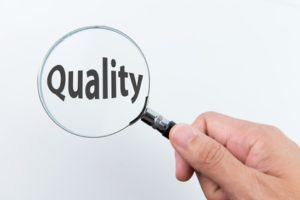ISO 9001 has been in existence since 1987, when it was known as BS5750. It was called the quality assurance standard. ISO 9000 was the guidance document. It was designed to help organisations meet the needs of customers and stakeholders while also meeting regulatory requirements relating to products and services.
The latest incarnation is ISO 9001:2015, which is a similar layout to the previous one, ISO 9001:2008 in that it follows a plan, do, check, act model in a process-based approach. The main development is the focus on risk-based thinking.
If you’ve been considering implementing a Quality Management System, and think that ISO9001 might be the way forward, here is some essential information to help with the decision.
Which organisations can certify to ISO9001?
We’re regularly asked what type or size of organisation you have to be to gain an ISO certification. The answer is simple: anyone, any number of employees, anywhere. The 2015 launch of the standard focuses particularly on ensuring the requirements can be applied to any size, type, or set up of organisation. There are provisions for how to demonstrate compliance, even if the organisation consists of one person working from their kitchen. A consultancy such as Assent will certainly have seen it all before and be able to provide the best consultant to guide you through the process with as little discomfort as possible. They will also make sure that you meet the requirements in the way best suited to your organisation, taking into account your customer and stakeholder expectations and needs.
What does ISO9001 involve?
The main elements of ISO9001 are based around meeting legal compliance and providing documents to demonstrate leadership, planning, support, operation, performance evaluation and continual improvement. How this is demonstrated depends on the processes and purposes of the organisation.
What do I have to do to get my organisation certified to ISO9001?
As a starting point, you might find it helpful to purchase a copy of the standard. Although it’s not exactly light bedtime reading, it’s the “bible” of ISO9001 and essentially an instruction manual. Our consultants are trained to work through the standard in a logical way and provide you with step-by-step guidance in completing all the requirements in the best way for your organisation.
If you decide to get a consultant to give you guidance, they will also be able to recommend the best certification body for you. At Assent, we can arrange quotes from three independent certification bodies to save you the legwork, and this is often quicker than trying to arrange the quotes yourself.
Your consultant will also ensure you have covered all the requirements of the standard prior to the first visit by the certificating body – known as a Stage 1 Audit. This is essentially a “starter” audit to ensure that you are ready to go for the full certification audit. Any findings that the certification body raise will be communicated to you, and your consultant will help you make any adjustments in preparation for the Stage 2 Certification Audit. Once the Stage 2 is successfully completed, and providing there are no further findings, your certification will be provided.
So, the process is not quite as daunting as it seems from the outside. ISO certifications are designed to benefit all types and sizes of organisation and can be combined into a unique structure to suit individual needs.
If you’d like to discuss support options, or need some further advice on the whole process, you can contact us and we’d be happy to provide guidance to get you on the path to ISO certification.


